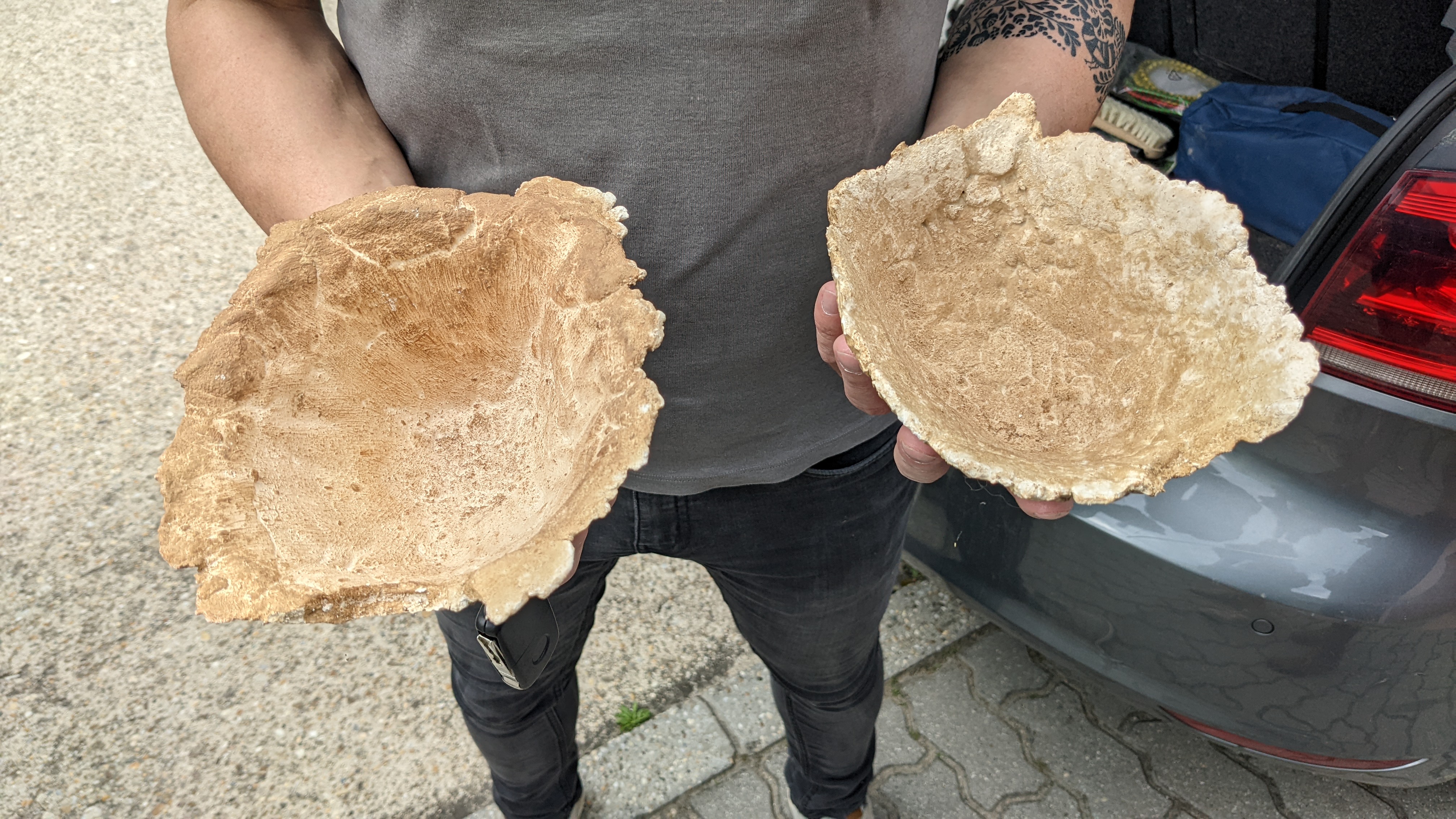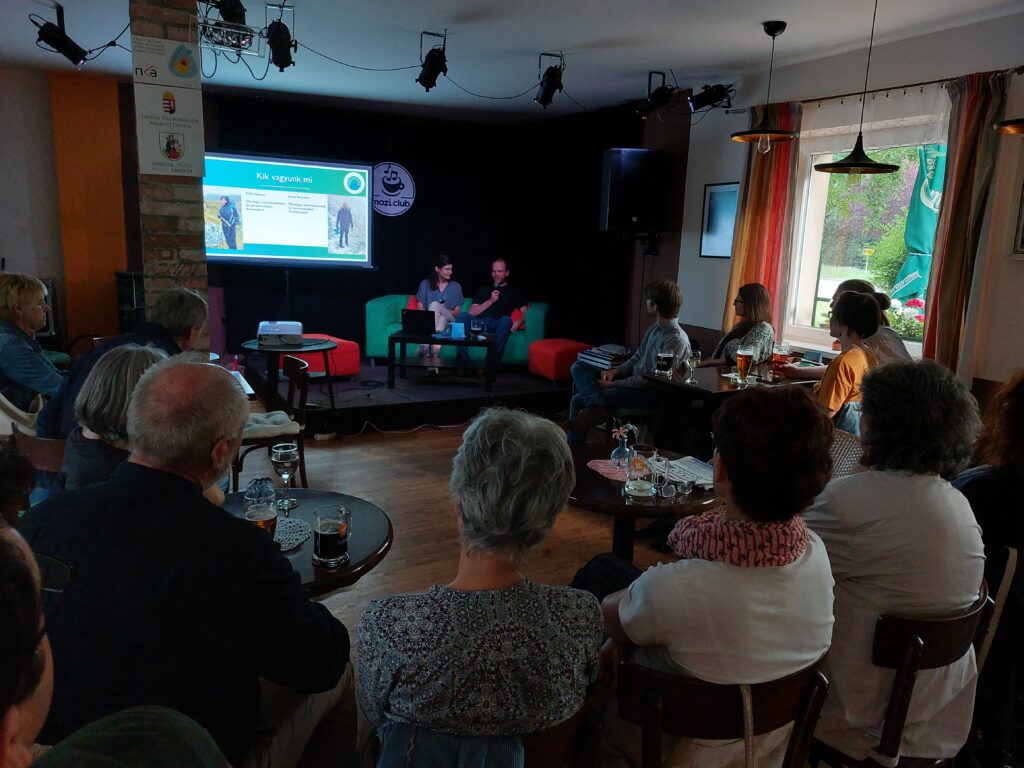“We can draw from nature, we can take from nature, if we can and want to give back.” This is the official motto of DunaVit, a young grassroots environmental protection organisation based in Csallóköz, Slovakia. We are talking truly grassroots. Registered in November 2020, DunaVit is not even two years old, but has made major achievements in the landscape protection of Csallóköz, the largest river island in Europe and largest drinking water reservoir in Central Europe.
During our visit to Somorja, we spent quite some time with László Tóth and Tamás Radočák from DunaVit. We visited one of their activities on site, and even organised a joint gathering at the local club, where we presented Biking4Biodiversity. Meeting DunaVit has been an inspiring encounter for us, from which we will surely draw a lot along our journey. Stick around and get to know them, it is definitely worth it!
Grassroots environmental protection
A few months ago, when the mission of our trip started to crystallise in our minds, we agreed that what we primarily seek to visit community-based initiatives. Undoubtedly, the surge in global awareness about various environmental issues can largely be attributed to the effectiveness and influence of grassroots movements. Both of us are big advocates for grassroots conservation, as we believe that action must come from all directions. Grassroots environmental protection happens locally, but has the power to virtually unite people anywhere to create change on a not only local, but also regional, national, or even global scale.
What distinguishes grassroots action from other forms of environmental protection is the emphasis on bottom-up, collective action to address a serious problem, often at the local level. People from completely different backgrounds and ages, who may not professionally work on the issues they address, come together and join forces for a common cause – to achieve positive change.
The mission of DunaVit
The establishment of DunaVit was closely linked to a 2020 petition of BROZ (Bratislava Regional Landscape Protection Organisation – Bratislavské regionálne ochranárske združenie), which called for the protection of the last remaining intact areas of the Inland Danube Delta in Slovakia. The aim of the petition was particularly to change the operating practices of the hydropower plant in Gabčíkovo/Bős.
At that time, there was no adequate local Hungarian-speaking organisation to raise its voice for the preservation of the landscape of Csallóköz, a region inhabited by Hungarians for centuries. László Tóth, one of the later founders of DunaVit, joined the petition and published it in Hungarian with the hope that the local Hungarian community would also support it. However, locals in the area showed minimal to no interest. Indifference to environmental issues is unfortunately widespread amongst the community.
This was the tipping point and inspiration for the three founders László Tóth, Péter Fodor, and Csaba Mészáros, all with deep family roots in the region, to join forces and form DunaVit. The aim of the organisation is to protect the environment, clean up the waters of the Danube, preserve and revitalise the beauty and natural environment of the Csallóköz. Therefore, the founders bring together all people, who share their passion, want to improve their environment and believe that environmental protection needs active participation of local people.
Only two years, but countless activities
In its short lifespan, DunaVit has achieved a jaw-dropping amount of progress towards a more natural Csallóköz. As we wrote in the previous article, Csallóköz – although being the largest inland river island of Europe with historically vast wetlands and floodplain forests – has become one of the most exploited, converted, cultural areas in Europe. Embedded in a densely agricultural landscape, it is not the easiest to achieve transformative change here. But DunaVit is determined, and their actions speak for themselves.
Some of their regular activities are biomonitoring, habitat restoration, waste collection and environmental education. The members of the association are also active in combating habitat destruction caused by large-scale farming. They joined a petition of the Slovak nature conservation organisation “Za živú krajinu” (For a Living Country), which calls on the Ministry of Agriculture to review its policies to support farmers who farm and cultivate their land in a close-to-nature way.
“The monoculture on hundreds of hectares of contiguous fields on the outskirts of Somorja are terrible for biodiversity. Currently for example, only wheat is grown, and last year it was only rape. This cultivation of such vast areas with one type of crop creates little to no habitats or corridors for wildlife, and therefore significantly reduces their chances of survival. If you look around, there are barely any nesting sites for birds, no hiding places, no food sources. Therefore, it is very important that the farming methods change, and we have already reached agreements with landowners to split some of the biggest contiguous fields into multiple smaller ones, and at least a few different types of crops simultaneously, to give this region a chance to revive its characteristic wildlife.” explains László Tóth.
The story of Barcs, a forgotten river
DuraVit’s activity that gained the biggest public attention was focusing on an unusual subject: a vanished river. The association has followed, explored and presented the traces of a forgotten river in the Danube basin. The Csallóköz region was once a network of rivers and streams. These were connected to the Danube, and when it flooded, some river beds moved or disappeared naturally. However, over the centuries, people have occupied and cultivated more and more land, which resulted in many important rivers and streams disappearing. DunaVit wanted to draw attention to the mistreatment of the landscape and our rivers through showing how Barcs, a river present in local documents from the 19th century, completely disappeared from the landscape in 100 years. The association therefore mapped the area of Csallóköz using a drone. The resulting photo exhibition shows the last known trail of the Barcs river. The team plans to continue this work, and if they can collect enough funding, they even plan to film a documentary and publish a book.
Somorja town Biodiversity plan 2021-2026
Last year, DunaVit even prepared a detailed concept of biodiversity development for the City of Somorja. In line with the territorial development plans of the city, this concept aims to set a direction for the conservation of the natural assets of this area, with particular attention to the landscape components affected by intensive agriculture. Habitat improvement and habitat creation are a key element of the concept, which has the following focuses:
1. Restoration of agricultural field paths
Research has shown that smaller patches of farmland can provide significant improvements to farmland biodiversity. Field paths dividing large agricultural areas provide shelter for different organisms and act as important windbreakers. Therefore, one of the most important actions for farmland biodiversity is to preserve and restore field paths. However, according to the current Slovak legislation, the tenant of the land is not obliged to maintain these strips, and may even grow crops on them at any time, which is unfortunately what happened on many fields around Somorja.
Together with László and Tamás, we visited one of these paths, which DunaVit is restoring. They are planting fruit trees, local flowers and bushes along the path to create a stretch of semi-wild meadow as shelter for many species. And indeed, since planting last autumn, life has already returned to this stretch – songbirds, butterflies and many insects have found new habitats here.
“We aim to reach a common ground with the tenants. Through clear reasoning, we work towards convincing them that they will not lose anything from their profits if they develop and maintain these vital paths. “ explains László Tóth. Tamás adds “Restoring these paths also enables locals to once again enter into these areas, can encourage them to explore, learn to value and eventually also protect farmland biodiversity.”
However, reaching agreements with stakeholders is not an easy task. Local hunters often claim that these paths and forestry roads are private property and put out “Do not enter” signs. That is why DunaVit took up the Sisyphean task of removing such illegally placed signs even though they might reappear somewhere else.
2. Canal restoration and connection
Harnessing old drainage, sewage and flood control canals for biodiversity conservation is another focus of the association. These canals are widespread components of the region’s agricultural landscape. Some of these, currently dry canals, have a big potential to function as refuges for native species in intensively managed landscapes. DunaVit aims to connect a currently dry sewage canal to the local canal network and reintroduce water flow, which would therefore unlock its potential of harbouring wide biodiversity.
3. Nestbox program to improve the breeding success of birds
The third part of the concept focuses on the creation of nesting sites for native bird species, whose habitat has shrunk due to extensive deforestation caused by the construction of the hydroelectric power plant. Only in the area of the City of Somorja, 13.6 km² of mainly floodplain forest, pasture and arable land have been flooded by the reservoir, due to which thousands of birds lost their nesting and feeding grounds. Research found that using nestboxes as compensation for lost bird nesting sites can cause a population to recover to ca. 50% of its original level. DunaVit has therefore created a detailed habitat suitability map and found that in the area of about 42 ha 398 nestboxes could be placed in suitable localities in the next five year period. With the help of volunteers, the association is gathering funding to build, place and manage these nestboxes, and revitalize the area as a suitable breeding site for birds.
Nature is worth fighting for everywhere
The Danube floodplains in Slovakia have suffered from environmental degradation much more than the mountain forests of the Carpathians. Nevertheless, the wetlands and floodplain forests in the Danube store lots of carbon, act as a natural water reservoir and provide protection during periods of drought. These habitats will be crucial for us to fight the consequences of the climate and biodiversity crises.
For locals, the Csallóköz region is their heritage. Local activists have fought for its protection for generations. Now, it is the duty of the current inhabitants to do the same for the generations that will follow. DunaVit showed us that don’t need to be a professional or have strong political power to bring nature back to an exploited area. The key is determination and willingness to act, coupled with a deep-rooted love for the natural values of the place you call home.
There is no other association like DunaVit in Csallóköz. If you like what they do, please consider supporting their efforts and making their plans a reality through donating, and if you are in the region, through volunteering work. You can find further information here:


















Pingback: Veľkolélsky Island – a gem in the Danube - biking4biodiversity.org
Pingback: Rioni – the overlooked refuge of sturgeons - biking4biodiversity.org